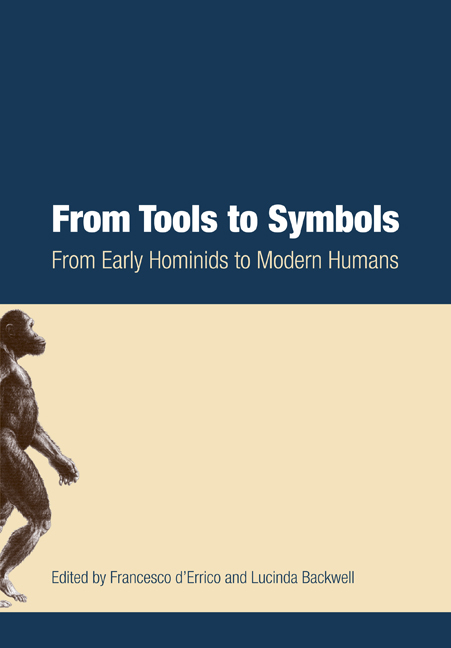Book contents
- Frontmatter
- Contents
- Acknowledgements
- Profile of Professor Tobias
- List of participants
- Foreword
- Address
- Keynote address
- Searching for common ground in palaeoanthropology, archaeology and genetics
- The history of a special relationship: prehistoric terminology and lithic technology between the French and South African research traditions
- Essential attributes of any technologically competent animal
- Significant tools and signifying monkeys: the question of body techniques and elementary actions on matter among apes and early hominids
- Tools and brains: which came first?
- Environmental changes and hominid evolution: what the vegetation tells us
- Implications of the presence of African ape-like teeth in the Miocene of Kenya
- Dawn of hominids: understanding the ape-hominid dichotomy
- The impact of new excavations from the Cradle of Humankind on our understanding of the evolution of hominins and their cultures
- Stone Age signatures in northernmost South Africa: early archaeology in the Mapungubwe National Park and vicinity
- Vertebral column, bipedalism and freedom of the hands
- Characterising early Homo: cladistic, morphological and metrical analyses of the original Plio-Pleistocene specimens
- Early Homo, ‘robust’ australopithecines and stone tools at Kromdraai, South Africa
- The origin of bone tool technology and the identification of early hominid cultural traditions
- Contribution of genetics to the study of human origins 276
- An overview of the patterns of behavioural change in Africa and Eurasia during the Middle and Late Pleistocene
- From the tropics to the colder climates: contrasting faunal exploitation adaptations of modern humans and Neanderthals
- New neighbours: interaction and image-making during the West European Middle to Upper Palaeolithic transition
- Late Mousterian lithic technology: its implications for the pace of the emergence of behavioural modernity and the relationship between behavioural modernity and biological modernity
- Exploring and quantifying technological differences between the MSA I, MSA II and Howieson's Poort at Klasies River
- Stratigraphic integrity of the Middle Stone Age levels at Blombos Cave
- Testing and demonstrating the stratigraphic integrity of artefacts from MSA deposits at Blombos Cave, South Africa
- From tool to symbol: the behavioural context of intentionally marked ostrich eggshell from Diepkloof, Western Cape
- Chronology of the Howieson's Poort and Still Bay techno-complexes: assessment and new data from luminescence
- Subsistence strategies in the Middle Stone Age at Sibudu Cave: the microscopic evidence from stone tool residues
- Speaking with beads: the evolutionary significance of personal ornaments
- Personal names index
- Subject index
Frontmatter
Published online by Cambridge University Press: 04 June 2019
- Frontmatter
- Contents
- Acknowledgements
- Profile of Professor Tobias
- List of participants
- Foreword
- Address
- Keynote address
- Searching for common ground in palaeoanthropology, archaeology and genetics
- The history of a special relationship: prehistoric terminology and lithic technology between the French and South African research traditions
- Essential attributes of any technologically competent animal
- Significant tools and signifying monkeys: the question of body techniques and elementary actions on matter among apes and early hominids
- Tools and brains: which came first?
- Environmental changes and hominid evolution: what the vegetation tells us
- Implications of the presence of African ape-like teeth in the Miocene of Kenya
- Dawn of hominids: understanding the ape-hominid dichotomy
- The impact of new excavations from the Cradle of Humankind on our understanding of the evolution of hominins and their cultures
- Stone Age signatures in northernmost South Africa: early archaeology in the Mapungubwe National Park and vicinity
- Vertebral column, bipedalism and freedom of the hands
- Characterising early Homo: cladistic, morphological and metrical analyses of the original Plio-Pleistocene specimens
- Early Homo, ‘robust’ australopithecines and stone tools at Kromdraai, South Africa
- The origin of bone tool technology and the identification of early hominid cultural traditions
- Contribution of genetics to the study of human origins 276
- An overview of the patterns of behavioural change in Africa and Eurasia during the Middle and Late Pleistocene
- From the tropics to the colder climates: contrasting faunal exploitation adaptations of modern humans and Neanderthals
- New neighbours: interaction and image-making during the West European Middle to Upper Palaeolithic transition
- Late Mousterian lithic technology: its implications for the pace of the emergence of behavioural modernity and the relationship between behavioural modernity and biological modernity
- Exploring and quantifying technological differences between the MSA I, MSA II and Howieson's Poort at Klasies River
- Stratigraphic integrity of the Middle Stone Age levels at Blombos Cave
- Testing and demonstrating the stratigraphic integrity of artefacts from MSA deposits at Blombos Cave, South Africa
- From tool to symbol: the behavioural context of intentionally marked ostrich eggshell from Diepkloof, Western Cape
- Chronology of the Howieson's Poort and Still Bay techno-complexes: assessment and new data from luminescence
- Subsistence strategies in the Middle Stone Age at Sibudu Cave: the microscopic evidence from stone tool residues
- Speaking with beads: the evolutionary significance of personal ornaments
- Personal names index
- Subject index
- Type
- Chapter
- Information
- From Tools to SymbolsFrom Early Hominids to Modern Humans, pp. i - ivPublisher: Wits University PressPrint publication year: 2005

